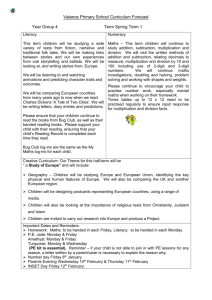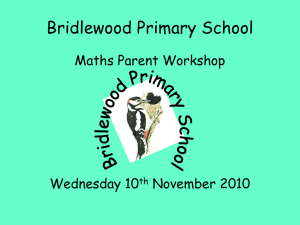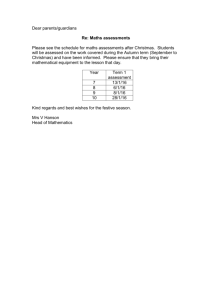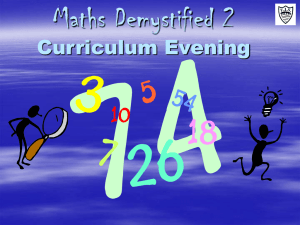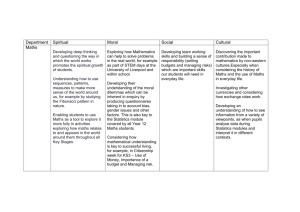Arithmetic 2 Progress Ladder
advertisement
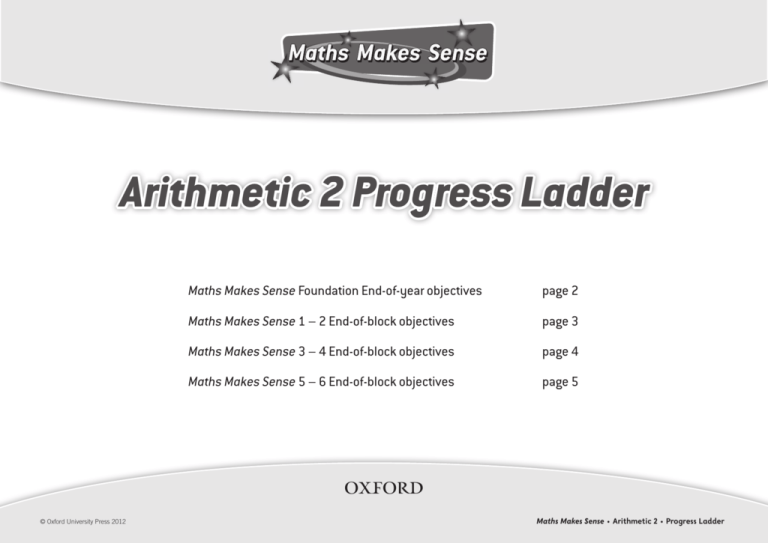
Arithmetic 2 Progress Ladder Maths Makes Sense Foundation End-of-year objectives page 2 Maths Makes Sense 1 – 2 End-of-block objectives page 3 Maths Makes Sense 3 – 4 End-of-block objectives page 4 Maths Makes Sense 5 – 6 End-of-block objectives page 5 2 © Oxford University Press 2012 Maths Makes Sense • Arithmetic 2 • Progress Ladder Maths Makes Sense Foundation End-of-year objectives Counting Number Writing • Participate in stories, songs and rhymes involving number, repetition and actions • Read, say and match numbers 0–9 • Recognise and write numbers from 0–9 • Read, say and match numbers 10–20 • Recognise and write numbers from 10 –20 • Count forwards starting at any number (0–1000) • Sequence numbers in order • Recognise and write fractions: ½ ¼ • Count backwards starting at any number (0–1000) • Match the number of objects to the numeral • Copy and write Maths Stories, e.g. 2 + 3 – 4 = 1 • Count up to 10 objects when asked How many...?, and reply with the correct number • Recognise and say numbers greater than 20 in an everyday context • Count objects when asked ‘How much is there here?’ and reply with, for example, [number] cups • Play simple games that involve use of number Calculating • Read what an addition or subtraction Maths Story with 1-digit whole numbers including ½ and ¼ (with a whole-number answer) says • Read what an addition or subtraction Maths Story with 1-digit whole numbers including ½ and ¼ (with a whole-number answer) means Shape Position • Recognise, name and describe 2D shapes • Follow instructions that involve positional language • Play simple games that involve use of number, pattern, shape and language • Give directions that include positional language • Act the Real Story for an addition or subtraction Maths Story with 1-digit whole numbers including ½ and ¼ with cups • Act out a Real-Life Story an addition or subtraction Maths Story with 1-digit whole numbers including ½ and ¼ using, e.g. pennies • Share objects into equal groups and count how many in each group • Participate in role play prompted by a Maths Story Sorting and data Measure Problem-solving • Sort objects such as playing cards, number cards, coloured objects, 2D and 3D shapes according to criteria • Use comparative language, such as bigger/smaller, shorter/ longer, heavier/lighter to compare quantities. • Use knowledge and skills of counting to solve simple problems, e.g. counting pairs of socks • Read information from a simple block graph • Tell the time using o’clock • Make a simple block graph using blocks or bricks • Use sand timers to measure minutes • Use knowledge and skills of songs and rhymes to join in with a modified song or rhyme, e.g. Three Little Dickie Birds • Use knowledge and skills of number and calculating to solve simple problems, e.g. sharing nine cakes between three friends • Use knowledge and skills of shape, position, sorting and measure to solve simple problems, e.g. building a room with construction bricks 2 © Oxford University Press 2012 Maths Makes Sense • Arithmetic 1 • Progress Ladder Maths Makes Sense 1 – 2 End-of-block objectives Maths Makes Sense 1 BLOCK 1 • Look at an addition or subtraction Maths Story with 1-digit whole numbers, zero, a half and a quarter and read what it says, e.g. Three, add a half, take away a half, add zero, equals three • Look at an addition or subtraction Maths Story with 1-digit whole numbers, zero, a half and a quarter and read what it means, e.g. Three cups, add a half cup, take away a half cup, add zero cup, equals three cups • Act the Real Story using addition and subtraction Maths Stories with 1-digit whole numbers, zero, a half and a quarter, e.g. 3 + ½ − ½ + 0 = 3 BLOCK 2 • Copy multiplication Maths Stories with 1-digit whole numbers, e.g. 2 × 4 = 8 • Act the Real Story using multiplication Maths Stories with 1-digit whole numbers, e.g. 2 × 4 = 8 • Look at the Maths Story and read what it says, e.g. Two, times four, equals eight. Look at the Maths Story and read what it means, e.g. Two cups, times four, equals eight cups. BLOCK 3 • Copy division Maths Stories with 1-digit whole numbers • Act the Real Story for division Maths Stories with 1-digit whole numbers, e.g. 6 ÷ 3 = 2 • For division Maths Stories with 1-digit whole numbers, look at the Maths Story and read what it says e.g. Six, divided by two, equals three, and look at the Maths Story and read what it means e.g. Six cups, divided by two cups, equals three. BLOCK 4 • Copy addition and subtraction Maths Stories with 1-digit whole numbers, zero, a half and a quarter, e.g. 2 + ½ + ¼ + ¼ + 1 = 4 • Copy multiplication and division Maths Stories with 1-digit whole numbers, e.g. 6 ÷ 3 = 2 • Act the Real Story using addition and subtraction Maths Stories with 1-digit whole numbers, zero, a half and a quarter, e.g. 2 + ½ + ¼ + ¼ + 1 = 4. Act the Real Story using multiplication and division Maths Stories with 1-digit whole numbers, e.g. 6 ÷ 3 = 2. BLOCK 5 • Use an embellished Real-life Story to say what a basic Real-Life Story, involving addition or subtraction with 1-digit whole numbers, is about, e.g. pens Maths Makes Sense 2 • Look at an embellished Real-Life Story involving addition, subtraction or multiplication and identify what the basic Real-Life Story is ‘about’, e.g. apples (I peeled one apple to make a pie. I peeled another two apples for the pie. My pie had three apples in it.) • Look at an embellished Real-Life Story involving addition, subtraction or multiplication and write the implied Maths Story, e.g. 1 + 2 = 3 (I peeled one apple to make a pie. I peeled another two apples for the pie. My pie had three apples in it). • Look at a Maths Story based on simple information from a grid, e.g. 1 + 3 = 4, and, say a basic Real-Life Story and say what the Real-Life Story is about, e.g. One pet add three pets equals four pets; the Real-Life Story is about pets. • Say and write an addition Maths Story to partition a 2-, 3- or 4-digit whole number, e.g. write 3246 = 3000 + 200 + 40 + 6, and say: Three thousand, two hundred and forty-six equals three thousand, add two hundred, add forty, add six • Read and copy mixed numbers accurately, e.g. copy 1¾ and read it as one and three quarters • Read subtraction Maths Stories as ‘difference between’ stories. • Complete different types of number puzzles • Continue a sequence of numbers or shapes and describe the connection between the steps, e.g. for the sequence 1, 4, 7, 10, identify that the next two steps are 13, 16, and that each step is three larger than the previous step • Complete a variety of number puzzles • Find halves and quarters of numbers and objects. • Use an embellished Real-life Story to draw a basic Real-Life Story involving addition or subtraction with 1-digit whole numbers, e.g. draw three pens and cross out two, to leave one pen • Use an embellished Real-life Story to say a basic Real-Life Story, e.g. Three pens, take away two pens, equals one pen • From an embellished Real-life Story, find and write an addition or subtraction Maths Story with 1-digit whole numbers, e.g. 3 − 2 = 1. BLOCK 6 • Say what a simple word problem, involving addition or subtraction with 1-digit whole numbers, is about, e.g. pens • Use the vocabulary of place value, e.g. thousands, hundreds, tens and units • Draw a basic Real-Life Story involving addition or subtraction with 1-digit whole numbers, e.g. draw three pens and cross out two, to leave one pen • Sort odd and even numbers using Carroll and Venn diagrams. • Write the number shown on an abacus • Say a basic Real-Life Story, e.g. Three pens, take away two pens, equals one pen • From a simple word problem, find and write an addition or subtraction Maths Story with 1-digit whole numbers, e.g. 3 − 2 = 1 • Answer a simple word problem involving addition or subtraction with 1-digit whole numbers, e.g. Ella had three pens. She gave two pens away. How many pens did she have left? 3 © Oxford University Press 2012 Maths Makes Sense • Arithmetic 2 • Progress Ladder Maths Makes Sense 3 – 4 End-of-block objectives Maths Makes Sense 3 BLOCK 1 • Calculate fractions of quantities using pupil cups, e.g. 2/3 of 6 = 4. Maths Makes Sense 4 • Use a grid to multiply a 2-digit whole number by a 2-digit whole number, e.g. 24 × 25 = 600 • Calculate answers to one-step word problems using addition, subtraction, multiplication or division, e.g. Nathan had 15 apples. He shared them among five friends. How many apples did each friend get? BLOCK 2 • Solve word problems involving fractions of quantities. • Use a calculator to solve one-step addition and subtraction word problems involving measures, with 4-digit numbers, e.g. Mira poured 2760 mℓ of milk into a jug. She then poured 1121 mℓ into the jug. What was the volume of water in the jug? • Use a calculator to solve one-step addition, subtraction, multiplication and division word problems involving measures, including decimals, e.g. Callum buys a comic every week which costs £1.67 and does this for eight weeks. How much does he spend? BLOCK 3 • Multiply a 2-digit whole number by a 1-digit number using a grid • Round numbers to the nearest 10. • Group together additions and subtractions to make calculating 3-digit addition and subtraction Maths Stories easier, e.g. 123 + 452 – 231 + 128 – 327 = 123 + 452 + 128 – 231 – 327 = 703 – 558 = 145 • Solve word problems about measures and everyday objects. BLOCK 4 • Solve word problems involving division (including answers with remainders) • Calculate division Maths Stories with remainders and write remainders as a number and as a fraction, e.g. 43 ÷ 5 = 8 r 3 or 8 3/5 . BLOCK 5 4 • Solve word problems involving decimal quantities, e.g. Three friends won £12.48 in a competition. They all got an equal share. How much did they each get? • Calculate answers to addition, subtraction, multiplication and division Maths Stories, including tenths written as fractions and decimal fractions • Solve word problems involving percentages of quantities, e.g. There are 600 children in a school. 5% of the children bring sandwiches for lunch. How many children is that? • Calculate vertical additions and subtractions including decimals (one decimal point only) • Solve word problems involving percentages of quantities using a calculator but without using the percentage key, e.g. The price of a £600 television is decreased by 8.3%. How much money is saved? • Write squares and square roots using written multiplication Maths Stories for reference. BLOCK 6 • Solve word problems using the sum of two products, e.g. Lila had three boxes with 22 pencils in each box, and two boxes with 31 pencils in each box. How many pencils did she have altogether? • Identify when addition is required to solve a word problem • Identify when subtraction is required to solve a word problem • Solve word problems using the four operations, fractions of quantities, percentages of quantities and the sum of two products, e.g. 3/4 of 12 metres, 5.3% of 640, 3 × 23 + 2 × 35 • Identify when multiplication is required to solve a word problem • Use the symbol ≈ for ‘approximately equal to’ (nearly equal to). • Identify when division is required to solve a word problem. • Round an answer with two decimal places to the nearest one decimal place, e.g. 33.92 ≈ 33.9. © Oxford University Press 2012 Maths Makes Sense • Arithmetic 2 • Progress Ladder Maths Makes Sense 5 – 6 End-of-block objectives Maths Makes Sense 5 BLOCK 1 • Complete missing number grids and missing number sentences • Complete sequences involving square numbers • Use information displayed in grids to solve word problems • Solve one- and two-step word problems involving any of the four operations. BLOCK 2 BLOCK 3 Maths Makes Sense 6 • Use a short method for multiplication of up to 3-digit by 2-digit whole numbers, e.g. 712 × 39 = 27 768 • Use a short method for division of up to 3-digit by 2-digit whole numbers, including remainders, e.g. 474 ÷ 13 = 36 r 6. • Use > / < / ≥ / ≤ with positive whole numbers, e.g. in the form 8 < m < 10 • Convert a vulgar fraction to a percentage • Use a calculator to check if a number is a factor of another number • Convert a percentage to a decimal fraction • Distinguish between a factor and a proper factor. • Convert a decimal fraction to a percentage. • Use divisibility tests for 2, 3, 4, 5, 6, 10 • Write the ratio of one quantity to another • Distinguish between factors and proper factors. • Write a quantity as a fraction or percentage of the total quantity • Solve word problems by calculating a quantity following a percentage increase or decrease. BLOCK 4 BLOCK 5 • Identify prime numbers from 0 – 0 using Eratosthenes’ sieve. • Solve word problems involving money using addition, subtraction, multiplication or division • Write numbers as the product of their prime factors • Add and subtract ‘squares’ and ‘cubes’ of numbers, e.g. find the sum of 102 and 8.73 • For n as a positive whole number, respond to a condition that describes a factor, e.g. 11 is a factor of n, and conditions that use the symbols < or ≤, e.g. 22 < n < 55, and write a value of n, i.e. 33 or 44. • Calculate the product of a given number closest to a specified number, e.g. find the product of 28 that is closest to 298. • Evaluate terms in an expression with brackets, e.g. (2 × 3) + (1 × 2) = 6 + 2 • Use inequalities to identify a range of possible values for a number, e.g. find the values of m, where 15 < m < 20 and m is a whole number • Evaluate products in an expression with brackets, e.g. 2 × (4 + 1 × 3) = 2 × (4 + 3) = 2 × 7. • Use algebraic notation for the sum, difference, product and quotient of two numbers, e.g. m + n, m − n, mn, m/n • Find the greatest or smallest sums, differences, products and quotients of two numbers with a range of possible values • Calculate the product of a given number closest to a specified number, e.g. calculate the product of 34 closest to 241. BLOCK 6 • Evaluate terms in an expression that includes brackets, e.g. recognise 5 + 4 + 2 × 5 as an expression with three terms, evaluate 5 + 4 + 10 and recognise 5 + (4 + 2) × 5 as an expression with two terms and evaluate 5 + 30 • Insert brackets in an expression so it has a specified value, e.g. calculate and write ‘2 × 5 + 1 + 2 = 13 and 2 × (5 + 1) + 2 = 14’ and also insert brackets for 2 × 5 + 1 + 2 to have the value 16. 5 © Oxford University Press 2012 • Solve number puzzles involving algebraic terms, use flow diagrams to identify inverse operations • Recognise algebraic representations of odd and even numbers • Identify two factors of a number, including numbers represented algebraically, and divide it by each factor, e.g. for 3k, 3k ÷ 3 = k and 3k ÷ k = 3. Maths Makes Sense • Arithmetic 2 • Progress Ladder
